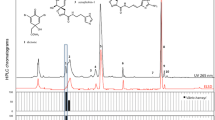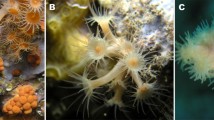Abstract
The ecological and applied importance of ascidian secondary metabolites is well reported, but little is known about temporal variation in the production of these compounds. Here, we examined seasonal variation in the production of the four main pyridoacridine alkaloids (shermilamine B, kuanoniamine D, and their deacetylated forms) of the purple morph of the ascidian Cystodytes sp. Five replicate samples were taken monthly from July 2004 to February 2006, and analyzed by high-performance liquid chromatography. Our results showed a high degree of intercolony variability in secondary metabolite concentration and a lack of statistically significant seasonal variation in the production of the four compounds. Minimum values, however, were consistently recorded over the studied years in late summer, after the reproductive period. These minima may be attributable to sexual exhaustion and seasonally varying biotic interactions or abiotic parameters.
Similar content being viewed by others
Explore related subjects
Discover the latest articles, news and stories from top researchers in related subjects.Avoid common mistakes on your manuscript.
Introduction
Tunicates are rich sources of secondary metabolites that often show interesting cytotoxic, antitumor, and antibacterial activities (Blunt et al., 2005). In addition, some studies have revealed important ecological roles of ascidian crude extracts and isolated metabolites (reviewed in Pawlik, 1993; Paul et al., 2006). Although the ecological and applied importance of tunicate secondary metabolites is well recognized, little is known about the dynamics of their production. The few existing studies have focused on the intraspecimen location, at both the cellular and organism levels (Pawlik, 1993; Paul et al., 2006).
Temperate seas present strong seasonal fluctuations in environmental parameters that are often reflected in the life-cycle patterns of marine invertebrates (reviewed in Coma et al., 2000). Therefore, temporal changes in the production of secondary metabolites can be expected as a result of trade-offs with other biological functions or as a response to biotic interactions, both of which vary seasonally. So far, however, no study has attempted to determine the temporal variation of co-occurring secondary metabolites in an ascidian.
Colonies of the ascidian Cystodytes spp. generally lack epibionts and present scarce signs of predation (López-Legentil et al., 2006). In the Mediterranean, (López-Legentil et al., 2005a) described two chemotypes in the nominal species C. dellechiajei, one of which presented the sulfur-containing pyridoacridines shermilamine B (1), kuanoniamine D (2), and their deacetylated forms, deacetylshermilamine B (3) and deacetylkuanoniamine D (4). All of them were isolated from a purple morph (Fig. 1). Some of these substances are cytotoxic (Bowden, 2000). In addition, the crude extract of this morph showed antipredatory properties against both puffer and damselfish, but not against sea urchins (López-Legentil et al., 2006). The main goal of this study was to establish whether there was a temporal variation in the production of these four pyridoacridine alkaloids.
Methods and Materials
Sampling
We monitored a population of the purple morph of Cystodytes in L'Escala (NE Spain; 42°06′52′′N, 3°10′07′′E). From July 2004 to February 2006, five different colonies per month were randomly collected by scuba diving. They were frozen alive, freeze-dried within a week, and kept at −30°C until analysis.
Chemical Extraction
Approximately 250 mg of each freeze-dried colony were weighed and extracted × 3 in a 1:1 (v:v) mixture of dichloromethane and methanol and passed through a 20-μm polytetrafluoroethylene (PTFE) filter. The resulting solution was dried by vacuum rotary evaporation. Each crude extract was redissolved in methanol, and the final volume was adjusted to 10 ml. An aliquot of 1 ml was passed through a 13-mm, 0.20-μm PTFE syringe filter before high-performance liquid chromatography (HPLC) injection. The injection volume was fixed at 20 μl.
HPLC Analysis and Quantification
The HPLC elution conditions consisted of eluants A (water/methanol/acetic acid, 9:1:0.1 v:v:v) and B (methanol), an elution profile based on a linear gradient from 0% B to 100% B in 10 min, and a flow rate of 0.8 ml min−1, with a fixed temperature of 30°C. We used an Agilent Eclipse XDB-C8 (4.6 mm ID × 15 cm) analytical column. Analyses were performed with a Waters Alliance 2695 Separations Module with a Waters 996 photodiode array detector. The sulfur–pyridoacridine purifications and identifications were performed as described by (López-Legentil et al., 2005a). Shermilamine B, kuanoniamine D, and their deacetylated forms were detected at 308 nm. The peak area obtained for each compound was integrated and compared to a calibration curve obtained by using each of the isolated pyridoacridines as an external standard. The final amount of each compound was calculated by averaging three replicate injections. All analyses were processed with Empower software.
Quantification of Total Organic Matter
After chemical extraction, the remaining colony pieces were oven-dried to a constant weight (60°C for at least 24 hr), placed in aluminum cups, weighed, and burned in a furnace oven at 500°C for 12 hr. Total organic matter content for each colony was obtained by subtracting the ash from the total dry mass weight. We standardized the metabolite concentration in relation to organic mass, as variations in inorganic material (e.g., spicules) could confound the results.
Data Analysis
For the analysis of the production of shermilamine B, kuanoniamine D, and their deacetylated forms over time, we used one-way analysis of variance (ANOVA) with time (month) as factor after checking for normality and homoscedasticity of the data. Nonparametric equivalents (Kruskal–Wallis test) were applied when necessary (detailed in the next section).
Results and Discussion
All samples showed a low chemical diversity, with four peaks, identified as deacetylkuanoniamine D (retention time, 4.5 min), deacetylshermilamine B (retention time, 5.4 min), kuanoniamine D (retention time, 7.2 min), and shermilamine B (retention time, 8.1 min). Changes in the concentrations of kuanoniamine D, shermilamine B, and their deacetylated forms (mean ± SE) are shown in Fig. 2 as the percentage of each compound relative to total organic matter. Deacetylshermilamine B was the most abundant compound, whereas kuanoniamine D was the least abundant. The percentages of deacetylkuanoniamine D and deacetylshermilamine B showed similar trends, with minima in September 2004 and August 2005 (Fig. 2a). However, only the production of deacetylkuanoniamine D significantly varied over time (Kruskal–Wallis, P < 0.001). Pairwise multiple comparison procedures (Dunn's method) revealed that values in September 2004 were significantly lower, and values in October 2005 significantly higher. No significant difference was detected for the production of deacetylshermilamine B over time (ANOVA, P = 0.073). The concentration of shermilamine B showed no significant variation with time (Kruskal–Wallis, P = 0.197), although a minimum was observed in August 2005 and a less marked one in September 2004 (Fig. 2b). There was also no clear temporal pattern in the percentage of kuanoniamine D (Kruskal–Wallis, P = 0.158), but minima were found in September 2004, February and August 2005, and December 2006 (Fig. 2b). The large standard errors found in the production of these compounds showed that there was noticeable interindividual variability, which is commonplace among sessile invertebrates. All in all, there was no clear seasonal pattern in the production of any of the four compounds studied, except for the presence of minimum values in late summer 2004 and 2005. There was no evidence either of a biotransformation between acetylated and deacetylated compounds (or vice versa) that would have been reflected by an inverse time course of their abundances.
Time course of the percentage of the four sulfur–containing pyridoacridines studied relative to total organic matter of each colony from July 2004 to February 2006. (a) Deacetylkuanoniamine D (dotted line) and deacetylshermilamine B (solid line); (b) kuanoniamine D (dotted line) and shermilamine B (solid line). Bars indicate standard errors (SE)
López-Legentil et al. (2005b) observed that the purple morph of Cystodytes had marked seasonal cycles for reproduction and growth, with larval release in summer (July–August) followed by a period of asexual growth. Investment in reproduction in this species is high, as the weight of larvae produced by a single zooid is almost equal to the weight of the zooid itself (Tarjuelo and Turon, 2004). Therefore, larval release (assuming they take secondary metabolites with them) could contribute to the low values in the production of deacetylkuanoniamine D and deacetylshermilamine B observed after sexual reproduction. However, these deacetylated compounds are present in both tunic and zooids (López-Legentil et al., 2005a), and the total mass of larvae is only 4% of the colony weight (Tarjuelo and Turon, 2004). A combination of larval release and “sexual exhaustion” after reproduction (Berrill, 1935) may account for the decrease in secondary metabolite concentration recorded in late summer 2004 and 2005.
Interacting organisms may also influence the production of secondary metabolites in Cystodytes. Predation and competition for space and food, if seasonally variable, may modulate the production of defensive secondary metabolites. Finally, abiotic factors should also be taken into account. Summer is an unfavorable season for many sessile filter feeders in the Mediterranean due to the existence of a food shortage period (Coma et al., 2000). This unfavorable season may be reflected by a decrease in investment in secondary metabolite production. A mixture of biotic interactions, and physiological and physical factors may all have shaped the trends observed in the production of the main pyridoacridine alkaloids.
References
Berrill, N. J. 1935. Studies in tunicate development. III. Differential retardation and acceleration. Philos. Trans. R. Soc. London 225:255–379.
Blunt, J. W., Copp, B. R., Munro, M. H., Northcote, P. T., and Prinsep, M. R. 2005. Marine natural products. Nat. Prod. Rep. 22:15–61.
Bowden, B. F. 2000. Aromatic alkaloids from ascidians. St. Nat. Prod. Chem. 23:233–283.
Coma, R., Ribes, M., Gili, J. M., and Zabala, M. 2000. Seasonality in coastal benthic ecosystems. Trends Ecol. Evol. 15:448–453.
López-Legentil, S., Dieckmann, R., Bontemps-Subielos, N., Turon, X., and Banaigs, B. 2005a. Qualitative variation of alkaloids in colour morphs of Cystodytes (Ascidiacea). Biochem. Syst. Ecol. 33:1107–1119.
López-Legentil, S., Ruchy, M., Doménech, A., and Turon, X. 2005b. Life cycles and growth rates of two morphotypes of Cystodytes (Ascidiacea) in the western Mediterranean. Mar. Ecol. Prog. Ser. 296:219–228.
López-Legentil, S., Turon, X., and Schupp, P. 2006. Chemical and physical defences against predators in Cystodytes (Ascidiacea). J. Exp. Mar. Biol. Ecol. 332:27–36.
Paul, V. J., Puglisi, M. P., and Ritson-Williams, R. 2006. Marine chemical ecology. Nat. Prod. Rep. 23:153–180.
Pawlik, J. R. 1993. Marine invertebrate chemical defenses. Chem. Rev. 93:1911–1922.
Tarjuelo, I. and Turon, X. 2004. Resource allocation in ascidians: reproductive investment vs. other life-history traits. Invertbr. Biol. 123:168–180.
Acknowledgments
J. Pawlik kindly made useful comments to improve this manuscript. Diving assistance was provided by C. Menniti and C. Palacin. This study was funded by a Ministry of Education and Science/Fulbright grant to S.L.-L., the project CTM2004-05265 of the Spanish Government, and by the Interreg IIIA n. I3A-1-72-E program of the EU.
Author information
Authors and Affiliations
Corresponding author
Rights and permissions
About this article
Cite this article
López-Legentil, S., Bontemps-Subielos, N., Turon, X. et al. Temporal Variation in the Production of Four Secondary Metabolites in a Colonial Ascidian. J Chem Ecol 32, 2079–2084 (2006). https://doi.org/10.1007/s10886-006-9148-2
Received:
Revised:
Accepted:
Published:
Issue Date:
DOI: https://doi.org/10.1007/s10886-006-9148-2






